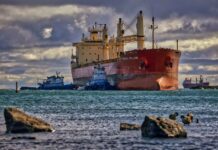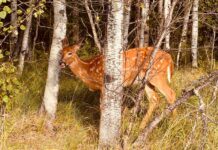“All glaciers in Iceland are retreating at an unprecedented pace,” says geologist who has studied them for 30 years
By Thin Lei Win
JOKULSARLON, Iceland – (Thomson Reuters Foundation) – The tourists come in droves, aboard buses, bicycles and camper vans. They stand at the water’s edge in awe of the icebergs floating before them – some as white as snow, others radiating a deep blue. They gasp when a chunk breaks off and topples into the chilly turquoise water.
Jökulsárlón glacier lagoon in southeast Iceland is one of the country’s top attractions. It is also a vivid warning of the glacier’s predicted disappearance, a devastating consequence of climate change in a nation where these slow-moving rivers of ice are a cultural and social touchstone.
It looks centuries old, but the lagoon only appeared in the mid-1930s when the Breiðamerkurjökull glacier started to retreat. Declared a nature reserve in July, it is now the country’s deepest lake and growing bigger every day.
Vatnajökull, Europe’s largest ice cap and the source of Breiðamerkurjökull, is thinning rapidly due to rising global temperatures and could be completely gone in 200 years, scientists say. Other glaciers may vanish much earlier.
“All glaciers in Iceland are retreating at an unprecedented pace,” said Oddur Sigurðsson, a geologist at the Icelandic Meteorological Office (IMO) who has studied them for 30 years.
Close to 10 glaciers with names, as well as many unnamed ones, have already disappeared, he told the Thomson Reuters Foundation.
Their demise heralds profound shifts in Iceland’s weather patterns, water flows, flora and fauna, volcanic activity and land mass, according to the IMO.
Iceland is becoming greener and some of its land mass is rising as climate change gathers pace, scientists say, bringing economic and other consequences.
But for many Icelanders – who like to call their nation the “Land of Fire and Ice” as a tribute to the glaciers and volcanoes that forged its stunning, otherworldly landscape – the loss of their glaciers is deeply personal.
“Just seeing them disappearing is very heartbreaking,” said Agnes Gunnarsdóttir, CEO of Perlan Museum in the capital Reykjavik. It is holding a state-of-the-art exhibition on glaciers and ice caves in a bid to educate tourists and residents about the impact of climate change on the environment.
Gunnarsdóttir remembers visiting her grandparents’ home in the countryside when Vatnajökull was much larger. “We are seeing this in our lifetime. It’s changing so quickly – it’s very scary,” she said.
Gudmundur Ögmundsson, manager of the Vatnajökull national park’s northern territory, has photographed Skaftafellsjökull, another outlet glacier of Vatnajökull, from a viewpoint on its western side for the past six years.
Part of the glacier was clearly visible in the 2012 picture, but it barely appears in this year’s image. Ögmundsson fears it will vanish completely by next year.
“There’s something so majestic about (glaciers) and then you see them on the decline. It’s sad,” he said.

RISING LAND
The loss of the country’s ice is accelerating. During the 20th century, about 10 percent vanished, followed by a further 3 percent in the first decade of this century alone. Scientists say rising temperatures, particularly during the summer, are largely responsible.
Temperature data going back 200 years shows episodic warming periods. But in the 21st century, large parts of Iceland have likely experienced the hottest years since the country was settled, said Halldór Björnsson, climate research group leader at the IMO.
Glaciers are Iceland’s greatest water storage receptacles. Covering at least 10 percent of its surface, they provide the tiny nation – home to just 330,000 people below the Arctic Circle – with abundant clean energy and spectacular waterfalls.
These draw in a rising number of tourists, who numbered 1.3 million in 2015, up from 320,000 in 2005.
Some of Iceland’s biggest power plants rely on glacier-fed rivers. As the glaciers melt, more water is flowing to the hydroelectric plants, but in the later part of this century, water volumes are projected to start decreasing, said Björnsson.
And while countries further south fret over land loss due to sea level rise as glaciers melt, parts of Iceland are experiencing sea level drop.
The thinning of large glaciers, such as Vatnajökull, reduces the load on the Earth’s crust near the ice masses, causing it to rebound and lift up.
A 2015 study using data from GPS receivers found that parts of south-central Iceland were rising by about 3.5 cm (1.4 inches) a year due to accelerated ice loss.
In Höfn, a port town in southeast Iceland known as its langoustine capital, the uplift is 1 cm per year, which translates into 1 metre per century.
“There is hardly any reasonable amount of sea level rise that will catch up with those rates,” said Björnsson.
Höfn’s harbour channel has become shallower due to sediment deposits, making it harder to reach the sea – and there may be other unforeseen complications, experts said.

UNAVOIDABLE IMPACTS
Volcanic activity is also expected to increase, as the melting of glaciers relieves pressure on volcanic systems, scientists say.
The eruption of glacier-tipped volcanoes can cause major melting of ice, leading to floods of historic proportions, Sigurðsson said.
These “jökulhlaups”, a type of glacial outburst flood, alter landscapes, devastate vegetation and threaten lives as well as infrastructure, including hydroelectric plants along glacier-fed rivers.
Yet Iceland still has no national strategy in place for adapting to climate change impacts, including melting glaciers. The country is working on an adaptation programme led by the IMO, the Ministry for the Environment and Natural Resources told the Thomson Reuters Foundation.
In the short term, the effects of climate change are expected to bring some economic benefits for Iceland, experts say. Warmer temperatures could enable cereal cultivation and boost energy production, while new fish species may flourish.
But Smári McCarthy, a parliamentarian for the Pirate Party representing the southern constituency including Höfn, said too little attention has been paid to adaptation.
“Iceland has reasonably good plans around reducing CO2 emissions, but I’ve not seen anything about how to deal with the unavoidable effects of climate change, or even a proper listing of anticipated effects,” he said.
For towns like Höfn that base their livelihoods on fishing, the prospect of the harbour closing down is “an existential risk” the government has yet to address, he said.
Some adaptation efforts are underway, however. Geologist Sigurðsson said the IMO is working on forecasting which rivers are liable to change course in the near future so adjustments in infrastructure can be made.
Meanwhile, national power company Landsvirkjun outlined plans in 2015 to expand storage capacity in some reservoirs to deal with increased water flow and climate impacts.

MELTING HISTORY
It may be difficult to imagine Iceland without its signature glaciers, immortalised in mediaeval sagas and literature such as Jules Verne’s “Journey to the Centre of the Earth”. But their passing is inevitable, Sigurðsson said.
Even if planet-warming greenhouse gas emissions were halted immediately, the glaciers would still disappear – along with a wealth of information – as global temperatures would continue to rise, he said.
The ice contains “a thousand years of history” about volcanoes and the climate, he noted, encapsulating “the entire history of Icelanders”.
“We expect the glaciers will completely disappear within 200 years, so we are losing five years of history every year,” he said. “Their history is something we must retrieve before they melt.”
(Reporting By Thin Lei Win, editing by Megan Rowling; Please credit the Thomson Reuters Foundation, the charitable arm of Thomson Reuters, that covers humanitarian news, women’s rights, corruption and climate change. Visit www.trust.org)







